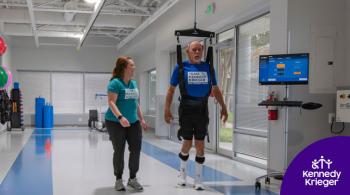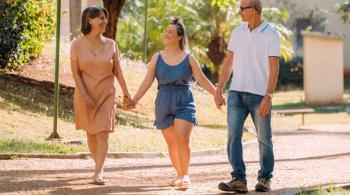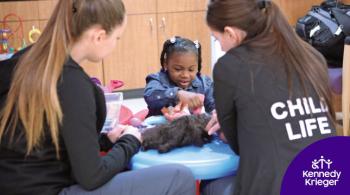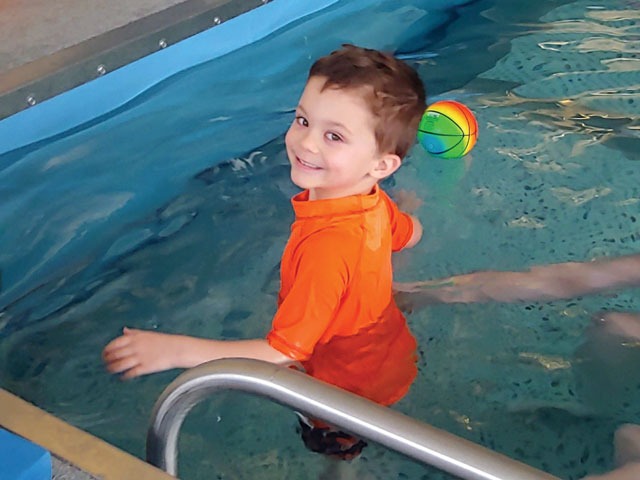
By Laura Thornton
The night before her son’s surgery, Michele wondered if she and her husband, Larry, had made the right decision. “I was worried about putting him through an elective surgery,” followed by weeks of inpatient rehabilitation. “I was scared he’d be miserable and want to go home.”
Tripp, 5, was born nine weeks early. When he was 2, Michele and Larry noticed he was walking on his tip-toes, with his left foot turned inward. As the months went by, they noticed more: Tripp could walk and run, but couldn’t jump or hop, and stairs were challenging. His gait was uneven, and his balance wasn’t great.
In January of 2020, Tripp saw Dr. Alec Hoon, who directs Kennedy Krieger Institute’s Phelps Center for Cerebral Palsy and Neurodevelopmental Medicine. An MRI scan revealed a periventricular leukomalacia (PVL)—a brain injury associated with Tripp’s early birth. Dr. Hoon diagnosed Tripp with spastic diplegic cerebral palsy, a neurological disorder, with spasticity—or tightness—in Tripp’s legs. Later that year, Tripp began outpatient physical therapy at the Institute.
While researching her son’s diagnosis, Michele learned about a surgery called selective dorsal rhizotomy, or SDR, that could help alleviate the spasticity. In May of 2021, Michele, Larry and Tripp met with the Institute’s Spasticity Clinic to learn more. Recovery would be lengthy: Tripp would need to lie flat on his back for the first three days after surgery, and would then need to learn how to walk with an even gait and his heels touching the floor with every step, through daily inpatient rehabilitation at Kennedy Krieger.
They decided to go for it. “We wanted to give Tripp the best possible chance of living his life to the fullest,” Michele says.
‘Off and Rolling’
On March 29, 2022, at The Johns Hopkins Hospital, pediatric neurosurgeon Dr. Shenandoah Robinson made a small incision in Tripp’s lower back. After determining which nerve rootlets at the base of his spine were causing muscle tightness, she cut them. Tripp still had plenty of nerves running from the base of his spine to the tips of his toes to be able to move his legs, but without the tightness caused by the spasticity, his legs were very weak. “He needed to build new strength in his legs and train his gait to be more symmetrical,” explains physical therapist Patricia Turlington.
Six days later, Tripp transferred to Kennedy Krieger, where his interdisciplinary care team eagerly awaited him. They fitted him for a special standing wheelchair, called a stander. With two big wheels on each side at the front, and two smaller wheels behind, it allowed Tripp to remain in a standing position for much of the day, building strength in his legs and torso.
“He was off and rolling,” Michele says. “He loved exploring in it.” While Michele met with Tripp’s new care team, Tripp got an in-person tour of the hospital he’d call home for the next month—and a glimpse at all the fun he’d have.
Fun-Filled Days
Tripp’s days at Kennedy Krieger were packed, with three hours of intense physical and occupational therapies every weekday, and half days on Saturdays.
“Tripp did amazingly well,” says Marianna Kogut, his inpatient physical therapist. “It’s important that after SDR surgery, kids relearn to walk the right way, so they don’t have an injury or further complications later on. The therapy can get a little boring, but Tripp made it fun.”
Tripp practiced walking with assistance, and then without. He loved being suspended in a harness over a treadmill—that way, he wouldn’t put more weight on his legs than they could handle, and Kogut could retrain his leg movements to improve the quality of his walking. “I’m flying!” he’d call out. He also loved letter hunts: Kogut would hide letter magnets in the hallway for Tripp, an early and avid reader, to find. He’d wear his cape—in orange, his favorite color, and emblazoned with a large “T.” As he picked up strength and speed, the cape would billow out a little more.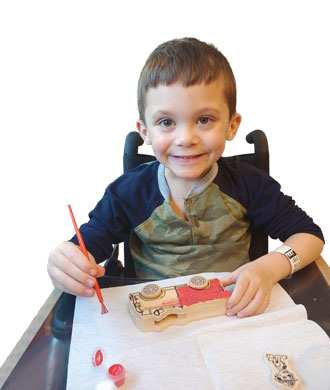
“We called him ‘Super Tripp,’” says Danielle Gilboy, his inpatient occupational therapist. Tripp began most of his days with Gilboy, who turned getting dressed and toothbrushing into fun therapy sessions to help Tripp develop his motor skills. “After SDR surgery, kids are with us for a while, which gives us a unique opportunity to offer more intensive services,” she explains.
Between therapy sessions, Tripp would visit the therapeutic recreation room of the Child Life and Therapeutic Recreation Department, where he’d play games like UNO and balloon volleyball, draw and paint, and do other fun activities. Therapeutic recreation specialist Patrick Pare coordinated with Tripp’s therapists to offer activities that would support his rehabilitation goals. One evening, Pare organized a hide-and-seek game. Caught up in the excitement, Tripp wheeled himself into hiding places in his stander, not realizing he was also getting a hefty dose of therapy. For Easter, the therapeutic recreation team organized a glow-in-the-dark Easter egg hunt.
Another evening, Pare organized a mini-golf game. “We like to introduce patients to different leisure activities so when they leave us, they already know some fun activities they can take part in. We’re looking ahead to long-term goals and getting back to being a part of the community, and just being a kid.
This place, and the people here and the care they provide, is amazing.” – Michele
The Road Ahead
“Tripp had a blast at Kennedy Krieger,” never once asking to go home, Michele says. But after four weeks of fun and incredible progress, it was time to move on to the next stage of rehabilitation: six weeks of daily physical therapy with Turlington at the Institute’s Specialized Transition Program, a neurorehabilitation day hospital, followed by ongoing outpatient physical therapy.
Michele tried to break the news gently, but Tripp was deeply saddened. “He actually cried when we were preparing to be discharged,” Michele says. “He didn’t want to leave.” Michele and Larry cheered Tripp up by reminding him of all the fun things that awaited him back home—playing with his dog, visiting with friends and returning to school.
Dr. Hoon credits Tripp’s tremendous improvement to both the integrated and personalized care Tripp received at the Institute, and to Michele and Larry, who “balance worry and apprehension with hope, love and determination, guiding Tripp to be his best,” Dr. Hoon says.
Michele has worked at Kennedy Krieger for the past 19 years, and had heard stories about how kids often don’t want to leave Kennedy Krieger, “but it’s hard to believe it until you see it,” she says. As director of special events for the Institute, Michele manages the Institute’s annual Festival of Trees and other major fundraising events. Her son’s experience at Kennedy Krieger has given new meaning to her work.
“I have a new outlook on the ways I want to get more involved in Kennedy Krieger,” she says. “This place, and the people here and the care they provide, is amazing.”











